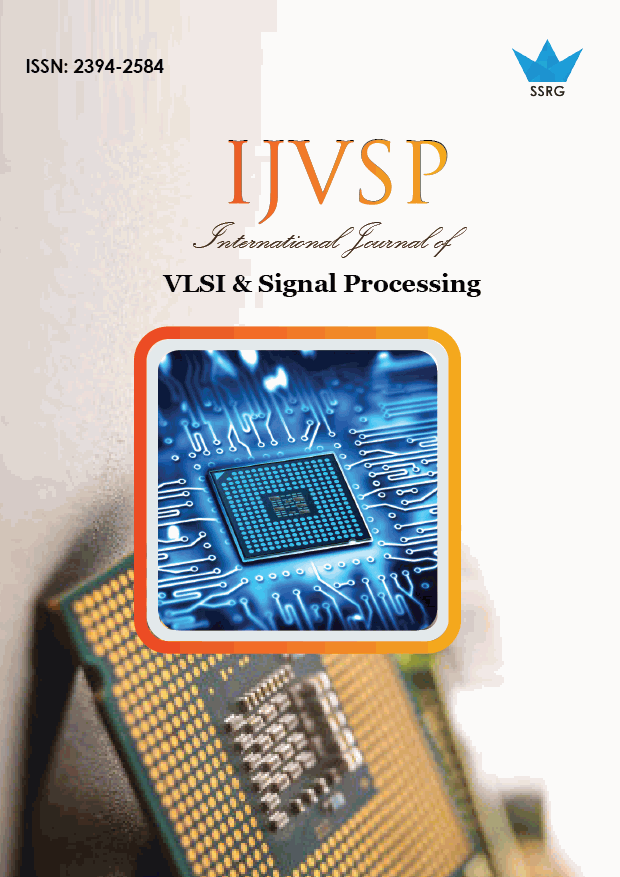Automatic Control of Wheel Chair using Hand Gestures in Signal Processing

| International Journal of VLSI & Signal Processing |
| © 2014 by SSRG - IJVSP Journal |
| Volume 1 Issue 1 |
| Year of Publication : 2014 |
| Authors : Dr.E.Sudhakaran Rao |
How to Cite?
Dr.E.Sudhakaran Rao, "Automatic Control of Wheel Chair using Hand Gestures in Signal Processing," SSRG International Journal of VLSI & Signal Processing, vol. 1, no. 1, pp. 13-15, 2014. Crossref, https://doi.org/10.14445/23942584/IJVSP-V1I1P105
Abstract:
This paper will be discussed about the controlling mechanism for the wheel chair for the physically disabled persons. This paper will mainly focus about the automatic detection of movement in wheel chair and its behavioural pattern. The wheel chair will be controlled by the signals which are propogated by the hand signals of the human being. This paper is decided to implement the novel approach to select the optimal posistion of the electrode. And it will be helpful to the foregoing process.
Keywords:
support vector machine algorithm, novel approach, hand gestures
References:
[1] Z. Lin, A. Saberi, M. Gutmann, and Y. A. Shamash, "Linear controller for an inverted pendulum having restricted travel: A high and-low gain approach,” Automatica, vol. 32, pp. 933-937, 1996.
[2] M. Bugeja, "Non-linear swing-up and stabilizing control of an inverted pendulum system,” presented at The IEEE Region 8 EUROCON on Computer as a Tool , 2003.
[3] Pei Jia, Huosheng H Hu, Tao Lu Kui Yuan, ̳Head gesture recognition for hands - free control of an intelligent wheelchair„,
[4] W. Zhong and H. Rock, "Energy and passivity based control of the double inverted pendulum on a cart,” presented at IEEE International Conference on Control Applications, (CCA '01). 2001.
[5] Z.-H. Xu, D.-M. Jin, and Z.-J. Li, "Using learning samples to construct fuzzy logic systems with the application to inverted pendulum control,” presented at International Conference on Machine Learning and Cybernetics. , 2002.
[6] J. Yi, N. Yubazaki, and K. Hirota, "Upswing and stabilization control of inverted pendulum system based on the SIRMs dynamically connected fuzzy inference model," Fuzzy Sets and Systems , vol. 122, pp. 139-152, 2001.
[7] N. Muskinja and B. Tovornik, "Swinging up and stabilization of a real inverted pendulum," IEEE Transactions on Industrial Electronics, vol. 53, pp. 631-639, 2006.
[8] HarpitSingh ,”Making Of PIC Microcontroller Instrument And Controllers”
[9] S. Fioretti, T. Leo, and S. Longhi , ̳A Navigation System for Increasing the Autonomy and the Security of Powered Wheelchairs„, IEEE Transactions On Rehabilitation Engineering, Vol. 8, No. 4, December 2000.
[10] ShilpaGulati, Benjamin Kuipers2008. “High Performance Control for Graceful Motion of an Intelligent Wheelchair”. Proceedings of the IEEE International Conference on Robotics and Automation (ICRA)
[11] Ren C. Luo, Tse Min Chen, Chi – Yang Hu, and Zu, Adaptive Intelligent Assistance Control of Electrical Wheelchairs by Grey - Fuzzy Decision-Making Algorithm„ , Proceedings of the 1999 IEEE International Conference on Robotics & Automation Detroit, Michigan May 1999.
[12] Yoshinori Kunotl, TeruhisaMurashimat ,NobutakaShimadat and Yoshiaki Shirait Interactive Gesture Interface for Intelligent Wheelchairs„.
[13] Donald P. Massa, ̳Choosing an Ultrasonic Sensor for Proximity or Distance Measurement Part 1: Acoustic Considerations„.
[14] Asebrandt, Susanne iwarsson and Agnetasta, "Older People„s Use of Powered Wheelchairs for Activity And Participation, Taylor and Francis health Sciences.
[15] A. Yamada, S. Yamakawa, and H. Fujimoto, "Switching Control for Inverted Pendulum System Based on Energy Modification,” presented at SICE Annual Conference, 2004.
[16] Rajesh KannanMegalingam*, Ramesh Nammily Nair*, ―Automated Voice based Home Navigation System for the Elderly and the Physically Challenged‖ Feb. 13~16, 2011

 10.14445/23942584/IJVSP-V1I1P105
10.14445/23942584/IJVSP-V1I1P105